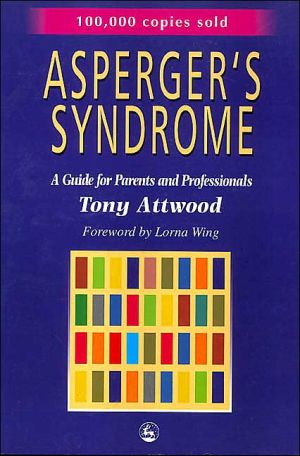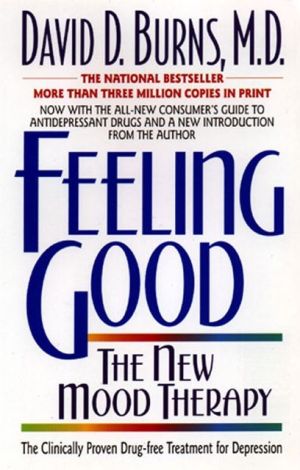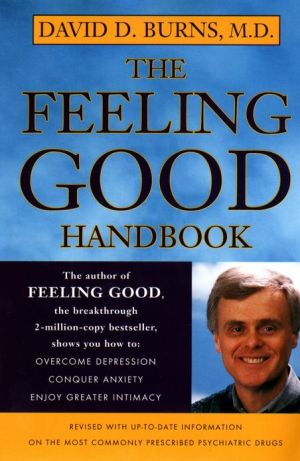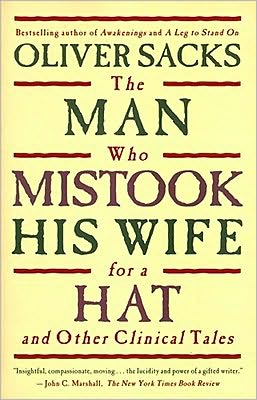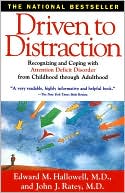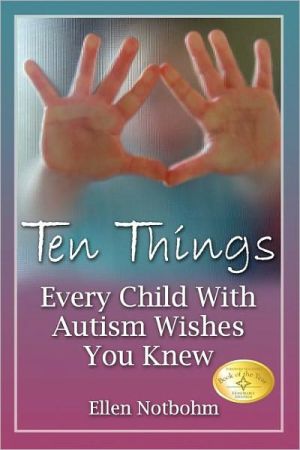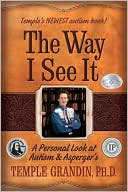Asperger's Syndrome: A Guide for Parents and Professionals
The Complete Guide to Asperger's Syndrome is the definitive handbook for anyone affected by Asperger's syndrome (AS). It brings together a wealth of information on all aspects the syndrome for children through to adults.\ Drawing on case studies and personal accounts from Attwood's extensive clinical experience, and from his correspondence with individuals with AS, this book is both authoritative and extremely accessible.\ Essential reading for families and individuals affected by AS as well...
Search in google:
Providing a description and analysis of the unusual characteristics of Asperger's syndrome, with strategies to reduce those that are most conspicuous and debilitating, this guide brings together the most relevant and useful information on all aspects of the syndrome, from language and social behaviour to motor clumsiness. Incorporating case studies from the author's own practical experience, the book contains many examples of, and numerous quotations from, people with Asperger's syndrome Amity Ruth This guide to Asperger's syndrome outlines the disorder, its associated deficits, and some frequently asked questions about the syndrome, and also provides additional resource materials. The purpose of this book is to provide an inclusive overview and description of Asperger's syndrome for non-specialists. It provides advice to parents and teachers about an unusual and, until recently, largely under-diagnosed syndrome. The author provides information regarding diagnostic criteria, the evaluation process, associated symptomatology, and practical suggestions for relating to individuals with Asperger's syndrome. The book also includes a qualitative description of the syndrome using vignettes and quotations providing insight into the experience of the disorder. This text is geared towards parents, teachers, and nonspecialists. This guide is useful to general practitioners as an introduction to the disorder, but is primarily designed as a comprehensive but general overview and should not be relied on as a technical treatment guide. The author provides some unique features in this text. A summary list at the end of each chapter helps summarize clinical strategies. The text includes rating scales, some clinical measures, and an appendix of formal clinical criteria to help identify the syndrome. It also provides reference materials on Asperger's syndrome and related subjects, including publications and web sites. This book provides a complete and clear description of Asperger's syndrome. It is well organized and gives substantive information on aspects of this disorder without confusing the reader with technical terminology. It is a particularly good text for teachers and parents whowish to gain a better understanding of the syndrome. The book not only outlines the clinical aspects and diagnostic criteria, but also provides the reader with a good sense of what it is like experientially for individuals with Asperger's syndrome and for those who interact with them.
Foreword9Preface111Diagnosis132Social Behaviour283Language674Interests and Routine895Motor Clumsiness1036Cognition1127Sensory Sensitivity1308Frequently Asked Questions141Appendix IResource Material on Emotions and Friendships186Appendix IIHow Do You Feel Today?194Appendix IIIDiagnostic Criteria195References202Subject Index216Author Index221
\ Doody ReviewsReviewer: Amity Ruth, BA (Northwestern University Feinberg School of Medicine) \ Description: This guide to Asperger's syndrome outlines the disorder, its associated deficits, and some frequently asked questions about the syndrome, and also provides additional resource materials.\ Purpose: The purpose of this book is to provide an inclusive overview and description of Asperger's syndrome for non-specialists. It provides advice to parents and teachers about an unusual and, until recently, largely under-diagnosed syndrome. The author provides information regarding diagnostic criteria, the evaluation process, associated symptomatology, and practical suggestions for relating to individuals with Asperger's syndrome. The book also includes a qualitative description of the syndrome using vignettes and quotations providing insight into the experience of the disorder.\ Audience: This text is geared towards parents, teachers, and nonspecialists. This guide is useful to general practitioners as an introduction to the disorder, but is primarily designed as a comprehensive but general overview and should not be relied on as a technical treatment guide.\ Features: The author provides some unique features in this text. A summary list at the end of each chapter helps summarize clinical strategies. The text includes rating scales, some clinical measures, and an appendix of formal clinical criteria to help identify the syndrome. It also provides reference materials on Asperger's syndrome and related subjects, including publications and web sites.\ Assessment: This book provides a complete and clear description of Asperger's syndrome. It is well organized and gives substantive information on aspects of this disorder without confusing the reader with technical terminology. It is a particularly good text for teachers and parents who wish to gain a better understanding of the syndrome. The book not only outlines the clinical aspects and diagnostic criteria, but also provides the reader with a good sense of what it is like experientially for individuals with Asperger's syndrome and for those who interact with them.\ \ \ \ \ From The CriticsReviewer: Amity Ruth, BA(Northwestern University Feinberg School of Medicine)\ Description: This guide to Asperger's syndrome outlines the disorder, its associated deficits, and some frequently asked questions about the syndrome, and also provides additional resource materials.\ Purpose: The purpose of this book is to provide an inclusive overview and description of Asperger's syndrome for non-specialists. It provides advice to parents and teachers about an unusual and, until recently, largely under-diagnosed syndrome. The author provides information regarding diagnostic criteria, the evaluation process, associated symptomatology, and practical suggestions for relating to individuals with Asperger's syndrome. The book also includes a qualitative description of the syndrome using vignettes and quotations providing insight into the experience of the disorder.\ Audience: This text is geared towards parents, teachers, and nonspecialists. This guide is useful to general practitioners as an introduction to the disorder, but is primarily designed as a comprehensive but general overview and should not be relied on as a technical treatment guide.\ Features: The author provides some unique features in this text. A summary list at the end of each chapter helps summarize clinical strategies. The text includes rating scales, some clinical measures, and an appendix of formal clinical criteria to help identify the syndrome. It also provides reference materials on Asperger's syndrome and related subjects, including publications and web sites.\ Assessment: This book provides a complete and clear description of Asperger's syndrome. It is well organized and gives substantive information on aspects of this disorder without confusing the reader with technical terminology. It is a particularly good text for teachers and parents who wish to gain a better understanding of the syndrome. The book not only outlines the clinical aspects and diagnostic criteria, but also provides the reader with a good sense of what it is like experientially for individuals with Asperger's syndrome and for those who interact with them.\ \ \ From The CriticsReviewer: Amity Ruth, BA(Northwestern University Feinberg School of Medicine) \ Description: This guide to Asperger's syndrome outlines the disorder, its associated deficits, and some frequently asked questions about the syndrome, and also provides additional resource materials.\ Purpose: The purpose of this book is to provide an inclusive overview and description of Asperger's syndrome for non-specialists. It provides advice to parents and teachers about an unusual and, until recently, largely under-diagnosed syndrome. The author provides information regarding diagnostic criteria, the evaluation process, associated symptomatology, and practical suggestions for relating to individuals with Asperger's syndrome. The book also includes a qualitative description of the syndrome using vignettes and quotations providing insight into the experience of the disorder.\ Audience: This text is geared towards parents, teachers, and nonspecialists. This guide is useful to general practitioners as an introduction to the disorder, but is primarily designed as a comprehensive but general overview and should not be relied on as a technical treatment guide.\ Features: The author provides some unique features in this text. A summary list at the end of each chapter helps summarize clinical strategies. The text includes rating scales, some clinical measures, and an appendix of formal clinical criteria to help identify the syndrome. It also provides reference materials on Asperger's syndrome and related subjects, including publications and web sites.\ Assessment: This book provides a complete and clear description of Asperger's syndrome. It is well organized and gives substantive information on aspects of this disorder without confusing the reader with technical terminology. It is a particularly good text for teachers and parents who wish to gain a better understanding of the syndrome. The book not only outlines the clinical aspects and diagnostic criteria, but also provides the reader with a good sense of what it is like experientially for individuals with Asperger's syndrome and for those who interact with them.\ \ \ \ \ Library JournalIn 1998, Australian clinical psychologist Attwood published Asperger's Syndrome: A Guide for Parents and Professionals, which quickly established him as an international expert on the condition. Here, he updates research in this rapidly evolving field, offering a wealth of information on childhood, college, long-term relationships, and careers. He gives comprehensive coverage of topics such as friendship, bullying, special interests, and theory of mind. Each chapter begins with a quote from Hans Asperger himself and includes firsthand experiences from individuals with Asperger's, including Temple Grandin, Liane Holliday Willey, and Stephen Shore. Particularly helpful are the "Key Points and Strategies" at each chapter's end and the detailed FAQs, glossary, resources, and references sections. Attwood writes, "I usually say to the child, `Congratulations, you have Asperger's syndrome,' and explain that this means he or she is not mad, bad or defective, but has a different way of thinking." His work skillfully brings together the current information on this fascinating condition and is an essential purchase for academic and public libraries. Elizabeth Safford, Nevins Memorial Lib., Methuen, MA Copyright 2006 Reed Business Information.\ \
